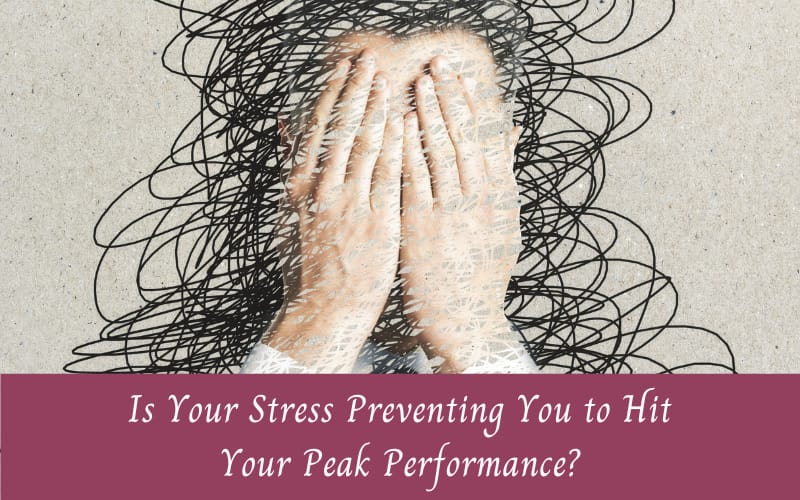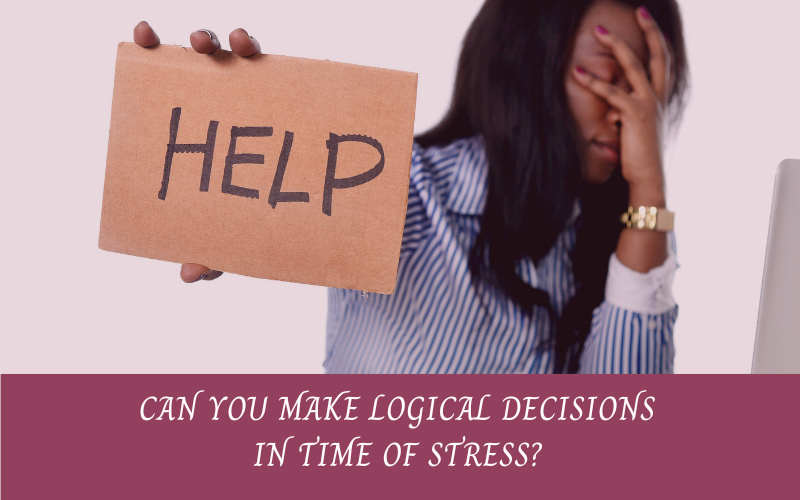
by Annika Sorensen | Dec 20, 2023 | Stress
In the fast-paced realm of high-achieving individuals, success often walks hand in hand with stress, creating a unique paradox that demands exploration.
This paradox – is what they call “The High-Achiever’s Paradox”.
Today, I’m going to untangle the intricacies of this paradox, exploring the impact of stress on leadership styles, strategies to prevent burnout, the ripple effect on team dynamics, and how success can be redefined beyond the boundaries of stress.
The High-Achiever’s Paradox: Unraveling the connection between success and stress
Success and stress, are the inseparable duo that often accompanies high-achievers on their journey to the top. The more success is achieved, the more stress one might have to endure.
The question is, how does this paradox shape the narrative of those who strive for excellence?
The Success-Driven Stress
For high-achievers, success is not just a goal; it’s a way of life. Every milestone reached is a testament to their dedication and hard work.
However, the pursuit of success can be a double-edged sword, bringing with it the stress of maintaining those high standards.
The fear of failure looms large, turning each success into a potential source of stress, or breakdowns over breakdowns…
Being a Perfectionist: The Silent Culprit
Picture an individual aiming for perfection in every endeavor.
While it may lead to remarkable achievements, the constant pursuit of flawlessness is a significant contributor to stress.
High-achievers, fueled by the desire for perfection, find themselves walking a tightrope, fearing any misstep that could tarnish their record.
The paradox lies in the fact that the very quest for success often breeds stress.
Balancing on the Tightrope
Success propels high-achievers to new heights. Each new summit reached means navigating an unfamiliar terrain. The adventure is thrilling, but it comes with its own set of challenges and uncertainties!
The stress of maintaining success in unfamiliar landscapes becomes a defining aspect of the high-achievers journey.
Navigating the Paradox of Success and Stress
So, how does one navigate the paradox of success and stress?
The key lies in acknowledging the symbiotic relationship between the two. Successful individuals who understand this paradox recognize that stress is not the antithesis of success… but a companion in the journey.
By embracing stress as part of the package, high-achievers can find harmony and redefine their relationship with success.
Impact on Leadership Style
For high-achieving leaders, the interplay between stress and decision-making is a crucial dynamic that shapes not only their paths but also the paths of those they lead.
For those who are in leadership positions, decisions are the currency through which goals are achieved, challenges are overcome, and teams are guided.
However, the pressure to make the right decisions can create a crucible that tests the limits of high-achieving leaders.
On the bright side…
Contrary to conventional wisdom, stress can be a catalyst for precision in decision-making for high-achieving leaders, as the weight of responsibility and the pursuit of success sharpen their focus, enabling them to sift through options with a discerning eye.
Stress, in this context, becomes not a hindrance but a refining fire that molds leaders into more effective decision-makers.
But there’s a TWIST: You have to be able to find the “SWEET SPOT” – the BALANCE.
Cracking the Code: Balancing Success and Stress
So, here’s the secret:
Success and stress aren’t enemies; they’re more like dance partners. Understanding this duo is key!
To navigate the delicate dance between stress and leadership decisions, high-achieving leaders must cultivate resilience. Recognizing that stress is an inherent part of leadership, they can adopt strategies such as mindfulness, delegation, and collaborative decision-making.
By acknowledging the paradox and proactively addressing stress, leaders can enhance their decision-making prowess and fortify the foundation of their leadership…
Navigating Burnout: Strategies for Preventing Burnout in High-Pressure Leadership Roles
In the relentless pursuit of excellence, high-achieving individuals often find themselves on the precipice of burnout. The demanding nature of leadership roles, coupled with the constant pressure to perform, creates a breeding ground for exhaustion. Navigating burnout becomes not just a personal challenge but a crucial aspect of sustaining high performance in leadership.
For high-achievers, the drive to excel can also inadvertently become a double-edged sword, contributing to the burnout they seek to evade.
So they must know how to spot one before it gets them.
Here are some techniques:
- Recognizing Burnout: A Call for Awareness
The first step in preventing burnout is the recognition of its subtle signs. High-achievers, accustomed to pushing their limits, may overlook the early indicators of burnout — persistent fatigue, a decline in productivity, and a sense of detachment.
Raising awareness about these signs is paramount for leaders and their organizations.
- Commitment to Self-care
Contrary to the notion of relentless perseverance, effective leadership requires a commitment to self-care.
High-achieving leaders must view self-care not as a luxury but as a strategic necessity. Adequate sleep, regular exercise, and moments of intentional relaxation become non-negotiable components of a leader’s routine.
- Setting Boundaries: A Leadership Imperative
Leadership often blurs the lines between personal and professional life. To prevent burnout, high achievers must establish clear boundaries from the very beginning.
This involves delineating specific work hours, designating periods for uninterrupted focus, and fostering a workplace culture that respects the importance of downtime.
- The Power of Delegation in Leadership
High achievers are accustomed to taking on significant responsibilities. However, effective leadership involves recognizing one’s limits and embracing the power of delegation.
Distributing tasks strategically not only prevents burnout but also empowers team members, fostering a culture of shared accountability.
5. Cultivating a Supportive Work Environment
Creating a supportive work environment where leaders feel comfortable expressing their challenges is instrumental in preventing burnout. This involves open communication, mentorship programs, and a collective commitment to the well-being of every team member.
6. Embracing Mindfulness Practices
In the chaotic landscape of high-pressure leadership, mindfulness emerges as a powerful antidote to burnout.
Integrating mindfulness practices, such as meditation and focused breathing, into daily routines helps leaders manage stress, enhance resilience, and maintain a clear perspective amid challenges.
7. Regular Assessments and Course Corrections
Preventing burnout is an ongoing process that requires regular assessments and course corrections.
High-achieving leaders and organizations must prioritize periodic evaluations of workloads, team dynamics, and individual well-being. This proactive approach allows for timely interventions before burnout takes hold.
Redefining Success: A Holistic Perspective
Ultimately, preventing burnout in high-pressure leadership roles necessitates a redefinition of success.
Beyond tangible achievements and accolades lies the importance of sustainable performance and holistic well-being. Leaders who prioritize their physical, emotional, and mental health lay the foundation for enduring success.
If you’re a high-achieving individual who would like to beat this High Achiever’s Paradox, here’s a good place to start!
To beating paradoxes,


by Annika Sorensen | Dec 8, 2023 | Stress
Ever feel like you’re juggling a mountain of responsibilities, and the stress just seems to hit its highest point? You’re not alone!
Stress, the unwelcome companion of daily lives, especially as a modern leader, can either be a stumbling block or a stepping stone… but it’s up to you to decide which one you want it to be.
In this blog, we will unravel practical strategies for leaders to not just endure but thrive amidst the chaos.
Work-Life Balance
The sweet melody of work-life balance… a rhythm that orchestrates not just professional success, but the very essence of a fulfilled life.
Imagine being a leader not just thriving in the boardroom but also savoring the precious moments outside it. It’s more than a luxury; it’s the soulful experience that transforms leadership from a demanding pursuit to a flourishing journey and a necessity for sustained well-being.
Leaders often find themselves caught in the whirlwind of responsibilities, but remember, a harmonious life outside work positively influences your effectiveness within it.
Work-life balance harmonizes your relationships, both personal and professional. Plus, it keeps you mentally healthy and on the other hand, without it, you’re always close to burnout.
Finding the Balance Between Work and Life
But really, work and life are hard enough already to balance even when you’re not yet in a leadership position…
So, how do we really achieve one?
Strategies for Leaders
- Importance of schedule: We know how there are unexpected times, but as much as possible, unless it is really an emergency and cannot be delayed at all, schedule dedicated personal time in your calendar, treat it as non-negotiable and communicate this boundary to your team.
A well-rested and fulfilled leader fosters a more productive work environment.
- Mindfulness: This is not just a trend, but a game changer. This empowers anybody to “stay and focus” at the present moment to make better decisions, avoid over-analysis, and manage stress more effectively.
A few minutes of focused breathing can set a calmer tone, enhancing collective focus and decision-making.
- A Supportive Organizational Culture: A workplace’s culture significantly influences the stress levels of its leaders and team members. Fostering a supportive culture that values well-being creates a resilient team.
To start with, establish open communication channels with regular check-ins, feedback sessions, and forums for sharing challenges to create an environment where stress is acknowledged and collectively addressed. Do not forget to celebrate wins and acknowledge everyone’s efforts too!
- Stress-Resilient Leadership Training: Just as athletes train to build physical resilience, leaders can undergo training to enhance stress resilience.
Equip yourself with the skills to navigate challenges without compromising your own well-being. Invest in leadership training programs that focus on stress management, emotional intelligence, and adaptive problem-solving.
A resilient leader inspires a resilient team.
“It’s not the load that breaks you down, it’s the way you carry it.”
Lou Holtz
Beware of Technology
While technology enhances efficiency, its unchecked use can contribute to stress.
Balancing the benefits of technology with mindful consumption is crucial, responsible use is a must.
What you can do, is to set ground rules for yourself to follow, such as establishing a technology-free zone or hours during the day. You can also share this with your team at work, maybe a zone dedicated to brainstorming sessions can make a tech-free zone, or maybe the brainstorming session itself is the tech-hour time of the day.
I know how helpful the internet is, so having an agenda for a meeting is important beforehand, so everyone can have their prepared gathered materials enough to spark creativity and enough to brainstorm ideas.
Plus, it encourages more engaged conversations too – that could help in fostering deeper and healthier connections.
DIVE DEEPER
If you want to dive or delve deeper into well-being practices for leaders, feel free to get a copy of my free guide for more actionable steps in stress-less leadership.
To a leadership journey that resonates with your well-being,


by Annika Sorensen | Nov 24, 2023 | Stress
In the whirlwind of today’s global business, stress wears different cultural hats. Think of it like a secret key to unlock top-notch leadership in diverse teams.
Ready for a colorful journey through the stressful landscape and how different cultures spice up the story? Explore with me the different leadership challenges brought by these cultural nuances, and get equipped with an actionable strategy for each!
Understanding Leadership Styles Across Cultures
Ever noticed how every culture adds its unique thread to leadership styles? It totally affects how we see and handle stress.
Leaders, picture this: you’re the captain navigating these differences. Whether you’re all about collaboration or follow a more structured approach, the goal is a stress-resilient team.
Conducting a stress-resilient team is not easy, as a team is made up of different people with different individuality, and different cultures and beliefs. But the best and most effective first step to achieving your goal is…
Host a workshop where team members can get to know more about each other on a deeper level and share their preferred work styles.
Then you may after use this insight to create a leadership approach that blends these diverse styles, making stress more manageable!
Communication Challenges in Multicultural Teams
So we already know how you’ve got a team with people from all walks of life. This also means… communication is the magic bridge, or sometimes a gap as it can be a bit wonky.
Stress levels skyrocket when language nuances and different communication styles clash.
So… what’s the trick?
Recognize and bridge these gaps for top-notch teamwork and stress-busting!
Or in simple words….
- Establish a Communication Code!
Work with your team to create a communication code that respects different styles. It could be as simple as using emojis for tone or having a weekly catch-up to discuss any communication hiccups.
Always remember to keep conversations open, honest, and progressive to avoid counter-productivity.
Cultural Norms and Stress Coping
Cultural norms are like the GPS guiding how we handle stress. Some cultures are all about community support, while others are more into individual coping styles.
Here’s the secret sauce: understand and respect these differences for a workplace where everyone feels supported in their stressful journey.
Plus…
- Implement a Buddy System!
Pair team members from different cultural backgrounds as stress buddies. They can then share coping mechanisms, fostering a supportive environment that respects and embraces diverse stress approaches.
Impact of Global Events on Stress Levels
Newsflash: global events shake things up and create a unique stress cocktail.
Economic shifts, world events, or health crises – it’s like a global stress party.
Leaders, your mission is to be the DJ, blending cultural sensitivity into the mix… This keeps the unity vibe strong amid diverse stress responses.
So as their DJ, you can…
- Host a Global Stress Check-In!
Regularly check in with your team about global events. Provide a safe space for discussions and ensure that everyone feels heard. This not only acknowledges cultural variations but also builds a resilient team that faces challenges together.
Ever experienced being at the foot of a global event but instead of hearing co-workers ask how you are, start reminding you about the deadlines you’re missing? You get it.
Cultural Intelligence as a Stress Management Superpower
Ever wished for a stress management superpower? Enter cultural intelligence!
It’s not just about understanding different cultures. It’s like turning that knowledge into a superhero cape, creating an inclusive and supportive space where stress doesn’t stand a chance.
But how can a leader get one?
- Through Cultural Training Sessions!
Invest in cultural training sessions for your team. Equip them with tools to navigate cultural differences effectively, turning stress into an opportunity for growth.
AND ALWAYS REMEMBER…
As we dive into the cultural aspects of stress, leadership becomes this epic quest. It’s about understanding the nuances, celebrating diversity, and leading with superhero empathy across your global team.
Ready for this cultural journey of leadership awesomeness? Check out my ultimate guide on stress, leadership, and turning your team into a global powerhouse.
To stress-resilient leadership and a world of cultural understanding,


by Annika Sorensen | Nov 15, 2023 | Stress
In the fast-paced world of hectic schedules and demanding responsibilities, stress often accompanies us like an unwelcome shadow.
But there is actually a transformative way to address this stress, something involving the intriguing connection between stress and “gut health”.
So here, I’ll tell you about the fascinating world of “Stress and Gut Microbiota.”
Navigating the Gut-Brain Connection
Simply put, our bodies are like networks, and in every network, there’s always a form of communication.
If our body is a network, then constant communication is also present – and that’s how it works between our brain and gut health. Our brains basically engage in constant communication with our guts.
But how does this connection happen?
That’s where our “gut microbiota” comes in — or the tiny organisms living in our digestive system which surprisingly, play a pivotal role in how our bodies respond to stress.
Stress and its Ripple Effect on Gut Microbiota
When stress comes running, it doesn’t just affect your mental state.
It automatically sends ripples of effect through your entire body, and through your gut microbiota as well.
Now these microorganisms, just like everything in our body, require balance. But as all delicate balances, these microorganisms can also be disrupted – potentially leading to digestive issues and a compromised immune system. Nasty, right? But that’s just how our bodies work.
Understanding How It Works
While there’s nothing we can do about the natural biology of our body, we can definitely work on understanding how they work.
Understanding the connection between stress and our gut microbiota allows us to grasp the profound impact stress can have on our overall well-being.
So how do we begin?
WE TAKE GOOD CARE OF OUR GUT.
Fueling Resilience: Nutrition for a Stress-Resistant Gut
How do we make sure our guts are healthy?
NUTRIENT-RICH DIET.
Yes, consider your diet a powerful ally in the battle against stress.
Opting for a nutrient-rich, balanced diet is like providing your gut microbiota with the tools to maintain harmony in the face of stress.
Whole foods, rich in fiber, vitamins, and minerals… they act as a buffer, enhancing your body’s ability to cope with stressors.
Probiotics: Guardians of Stress Resilience
Aside from a nutrient-rich diet, probiotics also play their role!
Probiotics are basically the unsung heroes in the realm of stress management.
Probiotics, or the beneficial bacteria found in fermented foods or supplements, contribute to the resilience of your gut microbiota!
By fostering a diverse and robust microbial community, probiotics can aid in maintaining equilibrium even during stressful times.
So make sure that aside from having a nutrient-rich diet, you throw on some probiotics too!
Holistic Approaches to Nurture Both Mind and Gut
What about the holistic approaches?
When aiming for holistic well-being, it’s crucial to approach stress management from MULTIPLE ANGLES.
Incorporating stress-relief practices like (a) mindfulness, (b) adequate sleep, and (c) regular physical activity contributes not only to mental resilience but also supports a flourishing gut microbiota.
These holistic measures create a harmonious environment for both your mind and your gut.
Importance of Understanding
In your journey towards balanced well-being, remember that understanding the interplay between stress and gut microbiota equips you with valuable insights.
By embracing a lifestyle that nurtures both mental health and gut resilience, you pave the way for a healthier, more resilient you.
Curious to delve deeper into stress management and gut health? Explore my step-by-step guide for additional insights on fostering well-being from within.
To a harmonious mind and a resilient gut,


by Annika Sorensen | Nov 6, 2023 | Stress
In the fast-paced business world, stress stands as a constant, but – decision-making is also constant.
Now, envision the two colliding: chaos, right? But not, if you know how to decode the relationship between the two.
The Connection Between Stress and Decision-Making
Let’s picture our minds as a “bustling intersection” where stress directs the flow of our thoughts: As stress becomes a player in this traffic, it subtly molds our decision-making process.
And it’s we all know it’s a lie if we say it’s not messy because it is!
But we also know that it’s not impossible. So how are some able to easily decide despite stress and pressure?
Familiar with the job requirements of: “Must be able to work under pressure/stress”?
Because some people can do that quite smoothly, while some… do not.
TYPES OF PEOPLE UNDER STRESS
There are three types of people in this world when it comes to stress:
- Those who still function and make decisions;
- Who allow stress to drive their decisions; and
- Those who just totally shut down.
Now, the question here is…
From which among the three do you want to categorize yourself, or do you want to be part of?
Importance of Stress Mastery as a Leader
The first step toward this mastery lies in acknowledging that there is always this intricate connection between stress and decision-making — and understanding that stress isn’t merely a mental state but plays a key role in shaping your choices.
The Science of Stress-Induced Decision Biases
Stress sets the stage for the release of cortisol, influencing the amygdala—the emotional epicenter of the brain. This hormonal interplay gives rise to decision biases, like a proclivity for familiar choices or an inclination to sidestep risks.
Unraveling these nuances empowers you to recognize and counteract the biases induced by stress.
Which makes it all… NORMAL, and HUMAN.
But Experience Is The Best Teacher
Yes, we’re all just human – and it is not a weakness if we experience in our lives that we let our emotions influence our decisions because scientifically, that’s what we do – BUT we must learn from that, to NOT do it every time!
Ever heard, “Once is enough?”
It’s the same here.
One wrong decision influenced by emotions is already more than enough to teach us that emotions must be separated from logic when a decision is required from us.
But acknowledging that it could also be hard, is mandatory for achieving mastery.
Still, there are things that you can do to make this journey easier…
Strategies for Enhancing Decision-Making Under Stress
Successfully navigating successful decision-making under stress necessitates a well-equipped toolkit of strategies, like:
- Commencing with mindfulness techniques, to foster an awareness of the present moment that opens mental space for clear decisions.
- Embracing structured decision-making processes breaks down complex choices into manageable steps, diminishes cognitive load, and fortifies your ability to confront challenges.
But it’s not enough to tackle stress only when a decision is required.
A great technique is knowing how to properly approach stress, from its very base, so that even when a decision is required at any time, you know how to fight stress head-on.
Stress Management for Optimal Decision-Making
Here are some tips to achieve effective stress management for optimal performance and decision-making:
- Embrace regular breaks, allowing your mind crucial moments of rejuvenation.
- Prioritize sleep to bolster cognitive function and resilience in the face of stress.
- Physical activity emerges as a potent ally, releasing endorphins that counteract stress hormones.
And of course, always…
BE PROACTIVE.
As proactive stress management lays the foundation for sharper, more effective decision-making.
Successful Decision-Making Amidst Stress
As I mentioned above, in the three types of people, there’s one who allows stress to influence their decision – which most of the time forbids success.
In the crucible of stress, successful decision-making arises from a blend of resilience and adaptability.
Here are some steps you can take to be the part of the ones that make successful decisions amidst the chaos of stress:
- Acknowledge that not every decision demands an immediate response.
- Allow yourself the space to reflect and gather information.
- Remember to focus on the information that you gathered and not the emotions that you are feeling.
- Separate your stress and ask yourself: “If I’m deciding without {the cause of stress/pressure}, and my decision won’t affect {your fear}, what’s the most logical thing that I would do/choose?
- Cultivate a growth mindset, perceiving challenges as opportunities for learning rather than insurmountable hurdles.
Your Guiding Compass
As you navigate the dynamic landscape of stress and decision-making, recognize that awareness and intentional strategies serve as your guiding compass.
By unraveling the connection between stress and decisions, you equip yourself to lead with clarity and purpose.
Be Able to Decide Successfully Amidst Stress
Ready to embark on this transformative journey? Download my COMPLIMENTARY GUIDE for additional insights on stress, decision-making, and holistic leadership.
To clarity in decisions and resilience in stress,







